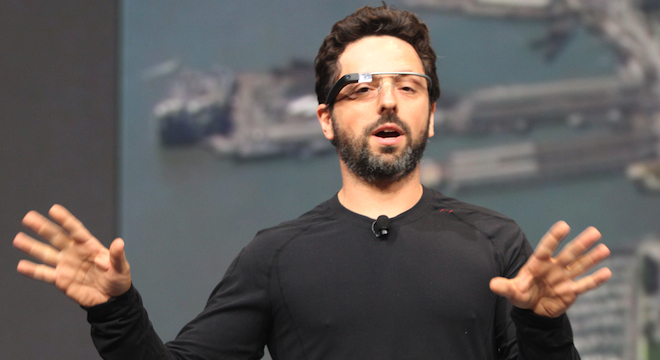Google executives on Wednesday announced a host of new products and services at the company’s developers conference, but none quite as surprising or potentially revolutionary as a pair of prototype high-tech glasses, Google Glass, which Google will begin shipping in early 2013, exclusively to U.S. software developers who attended the event, at a cost of $1,500 per pair.
These prototype devices are known as Google Glass “Explorer Edition.” The company has not yet said when the product will be available for general consumers, but with a pledge to ship physical pairs of the glasses, they do not appear to be vaporware.
Google co-founder and Glass research leader Sergey Brin took to the stage near the end of Google’s nearly four-hour long keynote presentation at its annual I/O developers conference held at the Moscone Center in San Francisco, wearing the computerized glasses, which he and other Google employees have been testing for the past three months following the prototype device’s unveiling in April.
Brin proceeded to act as the master of ceremonies for an elaborately staged introduction to the product, which involved a crew of stunt artists skydiving out of a blimp directly above the Moscone Center, parachuting down to the roof, where stunt BMX bikers proceeded to do backflips off strategically placed ramps and then rappel down the side of the building and enter the conference room where Brin was speaking, all while wearing pairs of Google’s high-tech specs, filming the action live from a first-person view, and wirelessly broadcasting it on a large screen on the conference room stage for all to see.
Check out a video here via CNET:
“This could go wrong in about 500 different ways,” Brin cautioned ahead of the stunt sequence, but was rewarded at the end when everything went smoothly and the stunt crew joined him on the stage.
Here are some screenshots of the action. First up, Brin, left, taking to the stage with his Google Glass pair, alongside Google social chief Vic Gundotra.

Then shots of the skydiving crew’s point-of-view, streamed as live video to the I/O developers conference attendees:




And here is a screenshot of Brin and the stunt bikers basking in the applause following the successful introduction here:

Here’s a Google video of the training that went into the skydiving portion, which includes shots snapped using the Google Glass devices:
After the stunt concluded, several other Google Glass engineers explained the progress of the new device’s development, showing on the I/O screen early versions that involved a gigantic backpack apparatus to the current version, which is literally just a set of ordinary-looking glasses frames, save for a tiny glass screen that fits above the wearer’s right eye and displays information from the embedded computer.
Google’s goal with Google Glass, according to the researchers, is to give users a less obtrusive consumer technology experience, removing the clunkiness of having to take out a separate device to take photos and video of everyday situations that they want to capture.
The researchers showed off more point-of-view videos and photos taken by employees with the Google Glass prototypes, including photos of a person jogging on a trail and another walking on the beach. Videos shown included someone jumping into a ball pit and another practicing pool and yet another cooking.
Finally, the demo concluded with a video of a couple live-streaming video of their baby to relatives across the country, using Google Glass combined with the company’s video “Hangouts On Air” personal broadcasting feature.

Ultimately, the company wants to be able to allow the Glass devices to be able to provide information to users on demand, but there was precious little actual layering of digital data, a process known as augmented reality, displayed in the demo Wednesday.
Google sources told TPM that the company won’t actually collect the $1,500 from developers up front, but rather just take the orders of those interested and then share with them product technical specifications and product support details, allowing the developers the ability to opt-out later, closer to the actual ship date, if they don’t want to spend that much.
One source said that interesed developers would receive access to Google’s research team behind the high-tech specs.
All in all, the Google Glass demo overshadowed the company’s other announcements, which were momentous in their own right, including a new version of Google’s Android mobile operating system called “Jelly Bean” version 4.1, a new Google Nexus 7 tablet made by Asus, a Google-made home media player called Google Nexus Q, and new features for Google Plus and Google Play.






